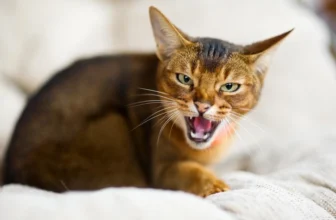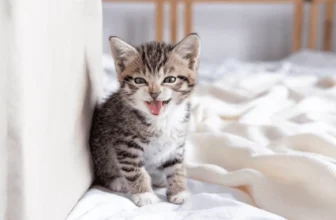Have you ever wondered what your American Wirehair cat is trying to tell you with their meows or body language? Understanding your feline companion’s non-verbal cues is crucial to forming a strong bond and ensuring their physical and emotional well-being. From the position of their ears and tail to the tone of their meows, every detail matters. In this article, we will delve into the various types of body language exhibited by American Wirehair cats and how to interpret them. We will also provide tips on effective communication with your furry friend, so you can build a loving and meaningful relationship. So, let’s explore the fascinating world of the American Wirehair cat together.
Types of Body Language in American Wirehair Cats
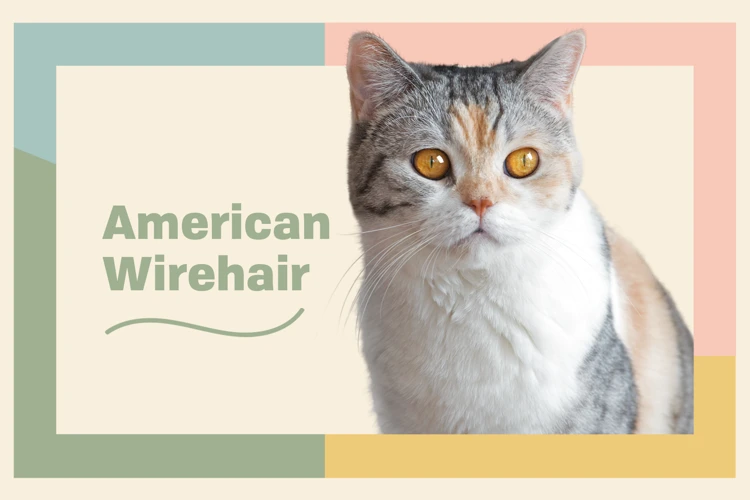
Understanding your American Wirehair’s body language is crucial if you want to build a strong and healthy relationship with your feline friend. While they may not be able to verbally communicate with you, their body language can speak volumes about how they’re feeling. By recognizing and interpreting different types of body language, you can learn to better understand your cat’s emotions and behavior. Let’s explore the different types of body language displayed by American Wirehair cats, including their ears, tail, eyes, and body posture. This understanding can help you identify potential problems that may cause excessive meowing in American Wirehairs, such as separation anxiety or medical conditions.
The Ears and Tail
American Wirehair cats can communicate a lot with their ears and tail. The position and movement of their ears and tail can indicate their mood and intentions. Here are some ear and tail positions to look out for:
- Relaxed ears and tail: If your American Wirehair has relaxed ears and tail, they’re likely feeling content and relaxed.
- Forward ears and upright tail: This can indicate that your cat is feeling curious or playful.
- Flat ears and tail: Indicates that your cat is scared or feeling defensive. It’s best to avoid approaching them when they are in this position.
- Tail twitching: Can indicate your cat is feeling irritable or agitated. It’s best to leave them alone until they calm down.
It’s important to keep in mind that each cat is unique and could display different body language cues. It’s important to look at the ears and tail in combination with other body language cues, such as the position of their body and the look in their eyes. Understanding all of these cues will allow you to better understand your cat’s mood and respond appropriately.
If your American Wirehair is excessively meowing, it could be a sign of anxiety or other health issues. It’s important to address this behavior and determine the underlying cause. You can read more about excessive meowing in American Wirehairs and how to address it.
Paying attention to your cat’s body language can improve your communication with them and strengthen your bond.
The Eyes
The Eyes:
Eyes play a crucial role in American Wirehair’s body language, just like humans. The size of the pupils can be indicative of mood. If your American Wirehair has dilated pupils, it may indicate excitement or arousal, while constricted pupils can be a sign of aggression or fear. Additionally, direct eye contact from a cat can be seen as a sign of aggression or dominance, but also of trust and affection.
Here are some other things to look out for in your Wirehair’s eyes:
- Slow blinking is a behavior that usually implies trust and relaxation. If your American Wirehair slowly blinks at you, return the favor as it is a way of communicating that you are not a threat.
- A fixed and intense stare or eyes that are widened can be a sign of fear or aggression, depending on what other body language cues are present.
- A half-opened blink can indicate contentment or fatigue.
As with the other components of body language, it is important to pay attention to context and other forms of communication when interpreting eye movements. For example, if your Wirehair has dilated pupils but a relaxed body, it may just be excited to see you. If it has dilated pupils and a tense body, however, it may be in a state of agitation.
If you are still unsure what your American Wirehair is trying to communicate through its eyes, consider seeking advice from a veterinary behaviorist or a cat behavior specialist. They can provide more in-depth information and help you understand what your cat is trying to say.
For more information on interpreting your cat’s behavior and meows, check out our tips on American Wirehair meowing, as well as advice on reducing excessive meowing and separation anxiety in American Wirehairs.
The Body Posture
A cat’s body posture is another important aspect to consider when trying to understand their communication. The American Wirehair cat’s body language includes various postures that can convey different meanings. Here are some of the most common body postures of American Wirehair cats:
- Relaxed posture: When your American Wirehair cat is relaxed, they will keep their body in a loose and comfortable position. Their legs will be tucked under their body or stretched out loosely. They may also lie on one side or the other with their paws tucked under their chest. This posture signifies contentment and relaxation.
- Tail Movement: The movement of a cat’s tail can reveal a lot about its mood. A loosely held, relaxed tail with a slight twitch is an indication that your cat is happy and relaxed. On the other hand, a tail held upright and very still can indicate that the cat is feeling aggressive or defensive.
- Arched back: If your American Wirehair cat’s back is arched and their fur is standing up, it usually implies that they are feeling threatened or scared. This posture is often accompanied by a hissing sound, with the cat trying to appear more significant than it actually is.
- Flat ears and wide eyes: When your American Wirehair cat’s ears are flat on their head, and their eyes are wide open, it usually means that they feel threatened or afraid. This posture indicates a defensive response, where the cat tends to withdraw or stay alert to avoid any attack.
- Stretching: American Wirehair cats will often stand up and stretch their front legs while their hind legs are firmly planted on the ground. This posture is usually a sign that the cat is feeling comfortable and relaxed. Stretching is also a sign that your cat is ready for a nap after playing or eating.
Cats can’t speak, and their body posture helps them convey their intentions and emotions. Understanding your American Wirehair’s body language correctly can help you manage their mood and keep things under control. If you’re struggling to figure out your pet’s behavior, it’s best to observe their posture and understand the context of their activities around that time.
Interpreting Meows and Body Language Together
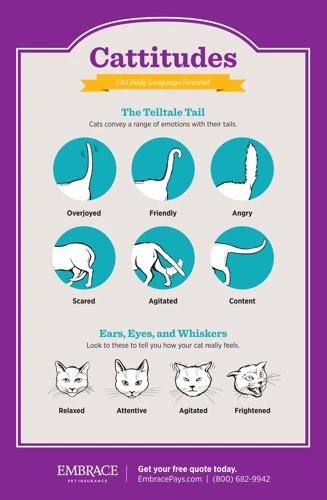
As cat owners, we all know how much our furry friends love to communicate with us through their meows and body language. But sometimes, understanding what they’re trying to tell us can be a bit perplexing. It’s not always clear what a meow or a certain body posture means on its own. That’s why it’s important to look at both aspects together to interpret your American Wirehair’s messages. In this section, we’ll explore how to understand your cat’s meows and body language and what they might indicate. To better comprehend your American Wirehair’s meowing behavior, check out our article on why American Wirehair cats meow.
Low-Pitch Meows with Loose Body Language
When an American Wirehair produces low-pitch meows with loose body language, it’s usually a sign of contentment. Your furry pal is happy and relaxed when they’re producing these sounds. It’s quite common for cats to meow with a low-pitch sound when they’re feeling comfortable. One quite fascinating thing about these meows is that they can serve as a way for cats to express their emotions without creating any unnecessary noise.
In fact, research has shown that some cats produce low-pitch meows when they’re in a particularly contented mood. You might hear these sounds when your Wirehair is playing with a toy or lounging in the sun. Your cat might even produce these sounds while you’re petting them.
As these meows and the loose body language indicate happiness, it’s essential to make sure your American Wirehair is feeling this way as often as possible. You can encourage this behavior by providing your feline friend with food, water, toys, and a comfortable environment. Ensuring that your cat has plenty of time to exercise and play is also essential in reducing their meowing.
However, if your American Wirehair’s meows become excessive, it’s best to consider consulting with a veterinarian. Sometimes excessive meowing can indicate underlying medical issues that need proper attention. Additionally, it’s important to make sure your cat has plenty of opportunities to enjoy playtime to reduce their meowing. You can read more about it in our article about reducing meowing in American Wirehairs. You can read more about medical conditions that can cause excessive meowing in American Wirehairs in our article about medical conditions that cause meowing in American Wirehairs.
Short and Purposeful Meows with Upright Ears and Tail
Short and purposeful meows with upright ears and tail: American Wirehair cats use this body language to communicate a sense of curiosity or a desire for attention. The short meows may be accompanied by gentle headbutts or rubbing of the head against their owner or object of interest. These meows are usually higher in pitch, indicating a positive and friendly attitude.
When you notice your American Wirehair cat giving these signals, it’s a good idea to engage with them in play or give them some affection. These types of meows can also indicate that your cat is hungry or needs something, such as their litter box cleaned or a drink of water. Responding positively to this communication can help strengthen your bond with your cat and provide them with a sense of security and comfort.
To enhance your understanding of this body language, here’s a table of the common non-verbal expressions and their interpretations:
| Body Language | Interpretation |
|---|---|
| Short meows with upright ears and tail | Curiosity or desire for attention |
| Gentle headbutts or rubbing of head against owner or object | Affection or marking territory |
| Higher-pitched meows | Positive and friendly attitude |
| Gentle pawing | Desire for play or attention |
Observing these non-verbal cues can help you interpret your American Wirehair cat’s meows and respond appropriately. Remember, these signals serve as a way for your cat to communicate their needs and desires, so it’s important to listen and engage with them in a positive and loving manner.
High-Pitch Meows with Tensed Body Language
When your American Wirehair cat meows with a high pitch and displays a tense body language, it signals a sense of discomfort or discomfort. This type of meow is often heard when your furry friend wants to communicate distress or needs your immediate attention.
Here’s a table that will help you understand the high-pitch meow and tense body language of your American Wirehair cat:
| Behavior | Meaning |
|---|---|
| Hissing or growling | This body language could indicate that your cat is feeling threatened or is in a fight or flight mode. Your cat may display a stiff posture with his ears turned sideways and pupils dilated. It’s essential to give your cat space and not force them into further discomfort. |
| Arched back and raised fur | If your American Wirehair cat meows with a high pitch and has an arched back, raised fur, and a tense posture, it could indicate that they are afraid or threatened. In such a situation, you need to remove your cat from the source of fear or anxiety. Try to calm your cat and only approach them when they appear relaxed. |
| Excessive grooming or licking | If your American Wirehair cat meows with a high pitch while simultaneously excessively grooming or licking themselves, it could indicate that they are experiencing physical discomfort, pain or stress. In such cases, consult with your veterinarian to ensure that your cat receives the necessary medical attention. |
When your American Wirehair cat meows with a high pitch and displays tense body language, it’s essential to approach them with caution and care. Be a patient and understanding pet parent, and consider consulting with your veterinarian if their discomfort persists.
Chirping Meows with Dilated Pupils
One interesting type of meow that you may notice from your American Wirehair cat is a chirping sound accompanied by dilated pupils. This can be a perplexing behavior to interpret because it’s not a typical meow sound that cats make. Chirping meows usually occur when your cat is excited about something, such as watching birds outside the window. It is a sound that cats make when they want to hunt.
When your American Wirehair cat chirps with dilated pupils, it usually means that they are in predatory mode, but it is not necessarily a sign of aggression. This behavior is usually harmless and a natural instinct for cats to hunt prey. This form of meowing is common in the American Wirehair cats, and if you have one, you may be lucky enough to experience it.
To better understand when your cat chirps, you should watch their body language. If their ears are pointed forward and their pupils are dilated, it’s a sign that they are in hunting mode and focused on something. You might see your cat hiding, crouching, or approaching something stealthily when they start chirping. They are probably trying to communicate their excitement about the possibility of catching their prey.
In these moments, it’s best to let your cat play and hunt, as long as they are safe and not in any danger. You can use toys, such as stuffed animals or laser pointers, to help them play and stimulate their instincts. Remember, chirping meows with dilated pupils is a natural behavior for your American Wirehair cat, and it’s essential to let them express themselves in a safe environment.
Common Verbal and Non-Verbal Expressions of American Wirehair Cats
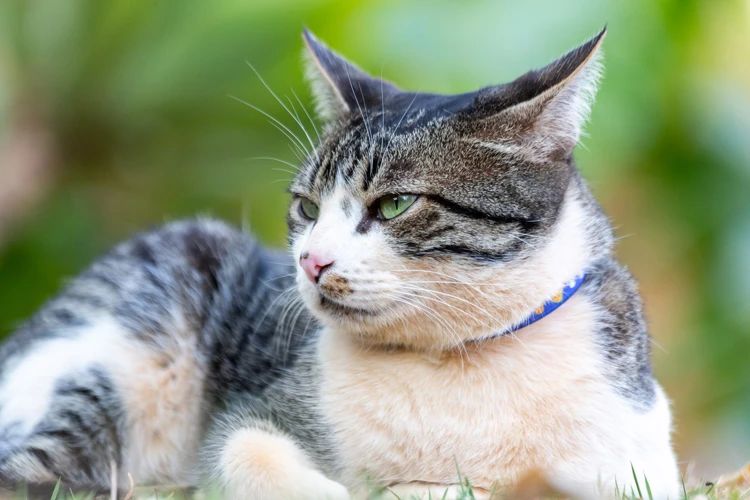
As a cat owner, it’s crucial to understand the expressions and body language of your feline friend. American Wirehair cats may not communicate in words, but they have their own way of conveying their emotions. By keenly observing their body posture, meows, and other non-verbal cues, you can decipher what your cat is trying to tell you. In this section, we’ll delve into the common verbal and non-verbal expressions of American Wirehair cats, so that you can create a strong bond with your furry companion.
Content and Relaxed
When your American Wirehair cat feels content and relaxed, they may display certain verbal and non-verbal expressions to show their contentment. It’s essential to understand their body language during such moments to ensure that you’re responding appropriately and building a stronger bond.
Here are some common verbal and non-verbal expressions of a content and relaxed American Wirehair cat:
| Expression | Description |
|---|---|
| Purring: | Continuous soft vibrations produced in the throat indicating pleasure and relaxation. |
| Slow blinking: | Closing and opening of eyes slowly indicating trust, relaxation, and happiness. |
| Relaxed posture: | The cat’s body is loose with no signs of tension, and they may even lie on their back exposing their belly. |
| Soft meows: | Quiet and soothing meows indicating a sense of calmness and peace. |
| Toes tapping and kneading: | The cat repeatedly tucks and untucks their paws, indicating relaxation and contentment. |
It’s essential to remember that when your American Wirehair cat is content and relaxed, they are in a positive state of mind and feel comfortable and safe in their surroundings. Interacting with your cat in such situations can enhance your bond and make them feel more relaxed and comfortable around you.
Fearful or Agitated
When an American Wirehair cat is fearful or agitated, they may display specific body language cues and verbal expressions. It’s important to be able to recognize these signs so you can help calm and comfort your kitty. Here are some common non-verbal and verbal expressions of a fearful or agitated American Wirehair cat:
| Non-Verbal Expressions | Verbal Expressions |
|---|---|
| Tail Position: The tail may be tucked tightly between the legs or held very low to the ground. | Hissing: Your cat may make a hissing sound to indicate fear or aggression. |
| Ear Position: The ears may be flat against the head. | Growling: A low growling noise can indicate anxiety and annoyance |
| Body Posture: Your cat may crouch down or flatten its body against the floor or wall. | Moaning: An American Wirehair cat might moan when it feels threatened or upset. |
| Pupil Dilation: The eyes may appear larger than usual and the pupils may be dilated. | Yowling: Loud yowling or meowing can be a sign of distress and fear. |
| Aggressive Stance: Your cat may stand up on its back legs, with its front paws spread wide apart. | Spitting: Spitting is a common expression of fear and agitation in cats. |
It’s important to remain calm and patient when your American Wirehair cat is displaying fearful or agitated behavior. Try to avoid approaching your cat too quickly or making any sudden movements that may startle it. Instead, speak to your cat in a soft and soothing tone to help ease its anxiety. If necessary, offer treats or toys to help distract and comfort your cat. Remember that each cat is different, and it may take some time to figure out what works best for your furry friend.
Aggressive
When an American Wirehair cat is feeling aggressive, their body language will exhibit signs of hostility, dominance and defensiveness. Understanding and responding to your cat’s aggressive behavior will help ease their distress and prevent them from lashing out at you or others.
Body Language
The body language of an American Wirehair cat when they are feeling aggressive is usually tense and puffed up. Their fur will stand on end, making their body appear larger and more intimidating. Their ears will also be flattened against their head, and their pupils will be dilated.
To further express their aggression, the cat may hiss, growl, and show their teeth. They may even lash out and try to swipe or bite. It is important to take caution when your cat is displaying this kind of behavior.
| Aggressive Behavior | What it Means | What to Do |
|---|---|---|
| Hissing | A warning to back off | Approach with caution or give space |
| Growling | A sign of irritation or anger | Remove the trigger or give space |
| Showing teeth | A clear sign of aggression and defense | Back off immediately |
| Swipe or Bite | Acting on aggressive impulses | Seek professional help and prevent future triggers |
Causes of Aggression
There are various reasons why an American Wirehair cat might feel aggressive. One of the most common reasons is if they feel threatened. This can be caused by other animals or people invading their space, loud noises, or sudden movements. Cats who are not properly socialized to humans or other animals may also become easily agitated.
Medical issues can also be a cause of aggression. For example, if a cat is in pain or discomfort, they may lash out as a defense mechanism. If you notice changes in your cat’s aggressive behavior or if it seems to have started without a clear trigger, it’s important to take them to the vet for a check-up.
What to Do
If your American Wirehair cat is showing signs of aggression, it’s important to give them space and time to cool down. Do not approach the cat or try to comfort them as this may further agitate them. Instead, remove any triggers that may be causing the aggressive behavior and give them a safe and quiet space to retreat to.
If the aggression continues or seems to be getting worse, seek professional help from a veterinarian or animal behaviorist. They can help determine the root cause of the aggression and provide you with the tools and techniques to effectively manage it.
As a responsible cat owner, it’s important to understand and respond to your American Wirehair cat’s aggressive behavior appropriately for their safety and well-being.
Protesting
When an American Wirehair cat is protesting, they are expressing their displeasure with something that is happening around them. This may include being handled in a way they don’t like, being put into a carrier, or even being given medication. It’s important to be able to identify this type of body language so that you can take steps to calm your cat and address their needs.
Body Posture: When a cat is protesting, they may tense up and become rigid. They may arch their back or puff up their fur to make themselves look bigger. Their ears may be flattened against their head and their tail may be twitching or thrashing.
Facial Expressions: A protesting cat may have dilated pupils, indicating that they are feeling stressed or anxious. They may also bare their teeth or hiss as a warning.
Verbal Communication: A protesting cat may let out a series of short, sharp meows or growls. These noises are a sign that they are unhappy with the situation at hand.
To help calm a protesting cat, it’s important to first remove them from the situation that is causing them distress. Once they are in a quiet and safe space, you can try to identify the root cause of their protests. This may involve changing the way you handle them or finding a new way to administer medication.
It’s also important to give your cat space and time to calm down. Avoid forcing them into any situation that may cause them to become upset again. Instead, let them come to you on their own terms and offer them treats or toys to help distract them from their previous discomfort.
Understanding your American Wirehair cat’s body language when they are protesting can help you address their needs and keep them happy and healthy. By taking the time to listen to their protests, you can create a better relationship with your feline friend.
| Body Posture | Facial Expressions | Verbal Communication |
|---|---|---|
| Tensed and rigid | Dilated pupils, bared teeth, hissing | Short, sharp meows or growls |
Effective Communication with Your American Wirehair Cat
Communicating effectively with your American Wirehair cat doesn’t have to be a difficult task. By understanding their body language and vocal cues, you can create a strong bond with your feline friend. Here are some tips to help you communicate effectively with your American Wirehair cat:
Pay Attention to Their Body Language
One of the keys to effective communication with your American Wirehair cat is paying attention to their body language. By observing their ears, tail, and body posture, you can understand how your cat is feeling. For example, if your cat’s ears are flattened, their tail is puffed up, and their body is tense, they may be feeling agitated or threatened. On the other hand, if your cat is relaxed with their tail and ears in a neutral position, they may be feeling content and happy.
Use Positive Reinforcement
One effective way to communicate with your American Wirehair cat is through positive reinforcement. When your cat exhibits positive behaviors such as using their litter box, playing with their toys, or coming when called, reward them with treats or affection. This will help reinforce these positive behaviors and encourage your cat to continue them in the future.
Be Patient
Patience is crucial when communicating with your American Wirehair cat. Cats are independent creatures and may not always respond to your commands right away. Remember to be patient and allow your cat time to adjust to new environments, people, or routines. Forceful or aggressive behavior can often lead to fear or aggression in cats, so it’s important to maintain a calm and patient demeanor.
Invest in Interactive Toys
American Wirehair cats are intelligent and curious creatures that need mental stimulation to stay happy and healthy. Invest in interactive toys such as puzzle feeders or laser pointers to keep your cat entertained. Interactive toys can also help strengthen the bond between you and your cat by providing a fun activity that you can enjoy together.
Listen to Your Cat’s Vocal Cues
Meowing is one of the primary ways that American Wirehair cats communicate with their owners. By listening to your cat’s meows and vocal cues, you can understand how they are feeling and what they need. For example, if your cat is meowing loudly and pacing around, they may be hungry or thirsty. On the other hand, if your cat’s meows are high-pitched and accompanied by tense body language, they may be feeling anxious or scared.
Effective communication with your American Wirehair cat comes down to understanding their body language and vocal cues, using positive reinforcement, being patient, investing in interactive toys, and listening to your cat’s needs. By following these tips, you can create a strong and healthy bond with your feline companion.
Conclusion
In conclusion, understanding the body language and verbal expressions of your American Wirehair cat is crucial for effective communication and building a strong bond with your pet. Observing the position of the ears, tail, eyes and body posture can give you a clear idea of your cat’s mood and intentions. Additionally, interpreting verbal cues such as meows can help you understand what your cat wants and needs.
It’s important to note that every cat is unique in their expressions and communicative styles, so it’s essential to spend time with your American Wirehair cat to get familiar with their individual communication patterns. Patience and a gentle approach are key to establishing a trusting relationship with your pet.
By respecting your American Wirehair cat’s boundaries and making an effort to understand their body language and meows, you can provide them with a safe and loving environment. This will not only benefit your cat’s overall well-being but also enhance the joy and satisfaction of being a cat owner.
Remember that effective communication is a two-way street, and it’s just as important to communicate with your cat as it is for them to communicate with you. Developing a deep understanding of your cat’s non-verbal and verbal cues can bring you closer together and strengthen the bond between you and your American Wirehair cat.
Frequently Asked Questions
1. Can American Wirehair cats use body language to communicate?
Yes, American Wirehair cats use body language to communicate their emotions and intentions to their owners and other animals.
2. How can you interpret an American Wirehair cat’s body posture?
Their body posture can convey whether they are feeling relaxed, defensive, or aggressive. A relaxed cat will have its body close to the ground and its muscles loose, while a defensive cat will raise its haunches and puff up its fur.
3. Do American Wirehair cats use different meows to communicate?
Yes, American Wirehair cats use different meows to express their needs and emotions. The pitch and tone of their meows can indicate their level of stress, happiness, and discomfort.
4. How can you tell if an American Wirehair cat is content and relaxed?
If an American Wirehair cat is content and relaxed, its pupils will be dilated, it will have a relaxed body posture, and it may even purr.
5. Do American Wirehair cats use their eyes to communicate?
Yes, American Wirehair cats use their eyes to communicate their mood and intentions. Dilated pupils can indicate fear or excitement, while narrowed pupils and a direct gaze can indicate aggression.
6. What does it mean when an American Wirehair cat chirps?
When an American Wirehair cat chirps, it can indicate excitement, happiness, or a desire for attention.
7. Can an American Wirehair cat’s tail position reveal their emotions?
Yes, an American Wirehair cat’s tail position can reveal their emotions. A tail held high indicates confidence or aggression, while a tail tucked between the legs can indicate fear or submission.
8. How can you communicate effectively with an American Wirehair cat?
You can communicate effectively with an American Wirehair cat by paying attention to their body language and acknowledging their needs. Respond to their meows and provide affection when they want it.
9. What does it mean when an American Wirehair cat arches its back?
When an American Wirehair cat arches its back, it can indicate fear or aggression. The cat is trying to make itself look bigger and more threatening to its perceived threat.
10. Are American Wirehair cats generally affectionate?
Yes, American Wirehair cats are generally affectionate and love to be petted and cuddled by their owners. They are loyal and engaging pets with playful personalities.




